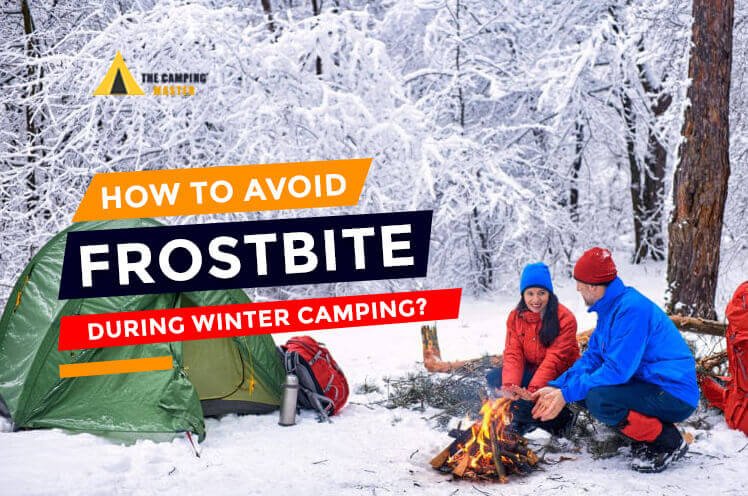Winter Camping is a unique experience to see the snowy landscapes for camping lovers. As a winter camp lover, snowy landscapes fascinate me, but the fear of getting frostbite always comes to my mind.
Hypothermia and frostbite are prevalent medical conditions that occur during winter camping. However, if you are a snow beauty lover, you should need proper preparation and safety measures. With the appropriate knowledge of frostbite safety and precautions, you can quickly stop it during extreme cold weather.
So here the question arises: How to avoid frostbite during winter camping? You can prevent frostbite during winter camping by adopting the following measurements. To keep your body warm by wearing thick woolen clothes, gloves, socks etc.
Ensure proper blood circulation. Warm clothes prevent heat loss and make appropriate blood circulation.
It would help to avoid tight clothes because they restrict blood circulation.
In this guide, I’ll delve into the essentials of frostbite prevention to ensure your winter camping adventures remain memorable for all the right reasons.
Let’s get started.
Understanding of Frostbite and its Risk
Frostbite is a medical condition that occurs with exposure to extreme cold temperatures. In this disease, our skin’s underlying tissues freeze or die from prolonged exposure to cold temperatures.
In freezing weather or low temperatures, the inner fluid of the cell is transformed into ice crystals, which are responsible for the complete death of the cells.
Frostbite has different stages, from frostnip to superficial frostbite and deep frostbite. Fingers, toes, ears, nose, and cheeks are most susceptible to this condition due to their distance from the body’s core warmth.
How Does Frostbite happen?
As we know, the average human body temperature is 37 degrees Fahrenheit. The human body needs to maintain its body temperature for everyday survival. When the human body parts come in contact with low temperature for a long time, the average body temperature gets low.
In the prolog cold contact, the sensory receptors of these exposed body parts send signals to the brain that lower the blood temperature in these body parts with cold exposure.
This cold blood, called hypothermia, circulates the other body parts and disturbs their functioning. In response to the sensory receptors of exposed body parts, the brain sends the signal to the body to contract all the vessels and veins of the exposed body parts to prevent heat loss.
The brain sends these signals because it can save your other vital organs, such as the lungs, heart, liver, etc. When the blood circulation is cut off in these areas, the exposed body parts die due to a lack of warm blood circulation.
Due to cold weather, the fluid inside your cell freezes, and the cell membrane ruptures, which is the real cause of cell death and tissue damage.
The freezing of these body parts due to lack of blood circulation is called frostbite. Below is the video of seasonal science that quickly explains the frostbite.
What Are the Symptoms of Frostbite?
In the following, I mentioned the early symptoms of frostbite and the severe symptoms of frostbite.
Early Symtoms of Frostbite
- Icy and prickling feeling in the impacted region
- Shift in skin hue from crimson to pallid complexion
- Loss of sensation
- Creation of blisters or crimson protrusions upon reheating
Sever Symtoms of Frostbite
- Pallid, devoid of color, and rigid skin
- Deep blue or blackish hue on the skin
- Absence of touch or sensation in the impacted area
- Incapable of moving the affected area
What Are the Stages of Frostbite?
Frostbite has 3 stages. These stages depend upon the longer cold exposure. As the cold exposure is prolonged, there is severe loss of tissues.
1. Frost Nip
The first stage is called frostnip. It is less severe and curable. In this stage, cold exposure discolors the skin color into pale, and the victim feels sensation and tingling in the affected area.
If this problem occurs, relocate to a warmer environment until your skin regains its original condition.
2. Superficial Bite
Long cold exposure of the body parts turned the cell water into ice crystals. In this situation, you still feel warm, but your hand swells and there are blisters on your skin.
To prevent this, keep your hand in warm water, saving some vessels or cells that are not entirely dead.
After warming your hand, you should dress up your wounds to save your body parts.
3. Severe Frostbit
At this stage, all sensation wanes, rendering your hands completely numb and immobilized. Even the deeper skin layers freeze, resulting in total cell death and the affected regions’ blackened appearance.
This stage requires urgent medical treatment or surgery; the affected part could be reduced. Regrettably, this stage is irreparable, often necessitating amputation to salvage the surrounding body parts.
How to Avoid Frostbite During Winter Camping?
I will discuss the main topic: avoiding frostbite during winter camping. You can easily prevent frostbite during extreme cold weather if you follow the precautions of safety tips. If it is treated timely, then it becomes less dangerous.
In the following, there are some tips that you should follow to enjoy your winter camping.
1. Insulated Tents
If you go winter camping, ensure your camping gear, such as tents, camping cots, hammocks, sleeping pads, mattresses, etc., are fully equipped to withstand extreme cold and windy weather.
Many camping gear companies claim they make lightweight tents for cold weather; however, they are unsuitable for heavy rainfall and windy conditions. However, I have written a detailed guide about the worst tent brands and recommended some excellent companies.
Moreover, I have written detailed reviews and guides about tents for extreme cold weather, the best tents with a stove jack, and the best tents for rainy weather. You can read it.
If your tent is not insulated and suitable for winter weather, you can check my other detailed guide about how to insulate a tent for winter camping.
If you are camping in freezing weather, then at least your sleeping pad is warm enough to keep your feet and hands warm all night.
2. Dress Warm Clothes
Your clothes are the first line to fight against cold. You must wear the right clothes during winter camping to stop the cold weather from affecting you.
You should wear warm clothes during winter camping. The suitable winter camping dress consists of three layers of clothes. You should wear
- an inner thermal layer of clothes
- mid fleecy layer
- moisture-repelling front jacket
You should also wear a woolen hat, socks, and gloves to protect yourself from cold temperatures. Ensure that all your dresses are not tight, as it would restrict your blood circulation because restriction in blood circulation can cause frostbite.
3. Intake of High Calories of Food
Intake of high food calories can prevent heat loss from your body. You should eat 4000-6000 calories, including three meals and two snacks daily. Cheese, butter, nuts, eggs, meat, and coffee are suitable for winter camping.
Eggs have high protein and are rich in calories. Read my deatailed review about best powdered eggs for camping. These are the perfect food for camping. If you are worried about packing eggs for camping, check out my guide about packing eggs for camping.
4. Drink Enough Water
Dehydration causes the blood pressure under skin flow. So, you should drink enough water to keep your blood flow accurate. It would help if you always kept a warm water bottle with you, preventing you from frostbite.
5. Change Wet Clothes
You should immediately change your clothes if you get wet during winter camping. Because wet clothes put water inside your clothes, which decreases the body temperature, and water causes heat loss from your body.
So, it causes a high risk of frostbite and hypothermia. It would help if you had separate clothes to change your wet clothes immediately.
You should also wear the upper, waterproof layer of clothes to remain safe during light rain or snowy camping. The maximum you should change the inner layer of clothes after some time.
6. Stay Active and Keep Moving
Movement helps maintain healthy blood circulation, reducing the risk of frostbite. Engage in light exercises or change your position frequently if you’re stationary for an extended period.
7. Harness the Power of Campfires
Campfires offer warmth and comfort and play a vital role in preventing frostbite. By providing heat to exposed areas like hands, nose, ears, and toes, campfires can help you stay cozy and protected.
8. Carry a Bottle of Warm Water
A bottle of warm water tucked beneath your clothing layers can provide periodic heat to your hands, ensuring they remain comfortable and warm.
Can You Treat Frostbite on Your Own?
You can treat the frostbite by yourself, depending on the situation. You can create it at home or at the campsite in the early stages.
In the unfortunate event of frostbite, emergency first aid is essential. Gradually rewarm the affected area using body heat or lukewarm water. you should void hot water, as it can cause further damage. Seek professional medical assistance, particularly for severe cases.
Extreme cold or windy conditions heighten the risk of frostbite. Supplement your strategies with chemical heat packs and hand warmers. Adapt your precautions to your needs and remain vigilant in recognizing frostbite symptoms.
Final Thoughts
Winter camping offers breathtaking landscapes and unique experiences but requires preparation and respect for nature’s challenges. By understanding frostbite, optimizing your clothing and shelter, staying active, and recognizing early signs, you can safely embrace the wonders of winter camping. Remember, your safety is paramount prioritize your well-being and make unforgettable memories on your cold-weather escapades.

